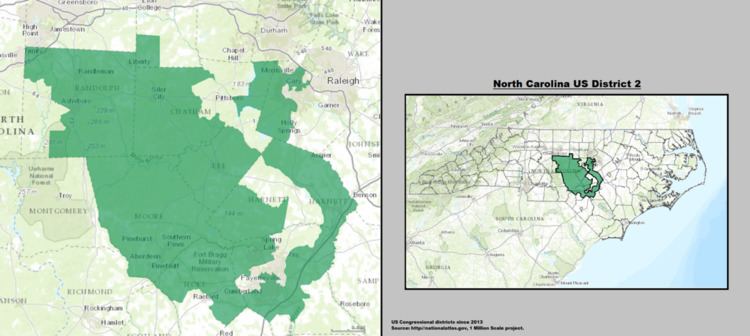Population (2000) 619,178 Cook PVI R+11 | Median income 36,510 | |
 | ||
Distribution 49.45% urban50.55% rural Ethnicity 61.8% White30.4% Black0.6% Asian7.9% Hispanic0.9% Native American0.3% other | ||
North Carolina's 2nd congressional district is located in the central and eastern parts of the state. Today, the district, which is represented by Republican Rep. George Holding, includes all or parts of Alamance, Chatham, Cumberland, Harnett, Hoke, Lee, Moore, Randolph and Wake counties.
Established by the state legislature after the American Civil War, the district was known as "The Black Second;" counties included in the district were mostly majority-black in population. All four of North Carolina's Republican African-American congressmen elected in the post-Civil War era (ending with George Henry White) represented this district, as did white yeoman farmer Curtis Hooks Brogden of Wayne County, a Republican ally of former Governor William Woods Holden.
After North Carolina Democrats regained control of the state legislature in the 1870s (using intimidation by the Red Shirts and other paramilitary groups to reduce the number of blacks voting), they passed voter registration and electoral laws that restricted voter rolls. Blacks continued to get elected to local and state offices. The state legislature passed a new constitutional amendment in 1900, which effectively disfranchised blacks altogether. This ended the election of blacks to local, state or Congressional offices until after passage of federal civil rights legislation in the mid-1960s, which enforced constitutional voting rights.
Thousands of blacks migrated north from the state in the Great Migration during the first half of the twentieth century, seeking job opportunities and education. By the later twentieth century, before the 1990s, the 2nd district was roughly 40% black. While it had the highest percentage of black residents of any congressional district in North Carolina, African-American candidates were unable to get elected to Congress from the majority-white district.
State redistricting following census changes led to the creation of the black-majority 1st and 12th districts and drew off some black population from the 2nd. Today the proportion of African-American residents is about 30.4% in the 2nd District.
